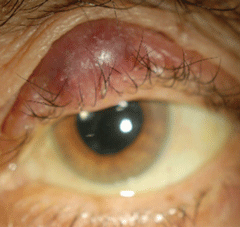 |
|
Online searches for ocular symptom, most notably stye (hordeolum), spike during the spring months. Photo: Alan G. Kabat, OD. Click image to enlarge. |
Before going to see a physician, people in today’s world increasingly rely on the internet—most commonly “Dr. Google”—to self-assess and self-diagnose various health issues. Although this can be troublesome, investigating data from online search engines can help inform healthcare research by enabling disease tracking and identifying lifestyle and health patterns. One recent study looked at five years of nationwide Google searches and discovered trends in nearly half of the ocular symptoms people inquire about on the internet, which the authors noted directly reflects the seasonality of allergic eye disease and ocular trauma.
The cross-sectional study reviewed publicly available Google trends data from 2015 to 2019. Ocular symptoms that people searched for on Google were divided into three categories based on involvement of vision change, eye pain or eye redness. Of the 106 ocular symptoms included in the analysis, the researchers noted that 48 (45%) demonstrated seasonal trends. The researchers use linear regression analysis, a statistical method of predicting one variable from the presence of another one; the metric r2 indicates the strength of the association on a 0 to 1 scale.
These seasonal trends were associated with the following search terms: stye (r2=0.89), pink eye (r2=0.82), dry eye (r2=0.76), blurry vision (r2=0.72) and swollen eye (r2=0.71).
“Periodic search terms were more likely to involve eye redness (21% vs. 11% for non-periodic search terms) and less likely to involve vision change (11% vs. 36%),” the researchers wrote in their paper. “Periodic queries involving eye redness most often peaked in the spring, and those involving eye pain peaked in the summer.”
Overall, ocular symptoms that showed seasonal trends were also searched for on Google more often in the spring than any other month. The authors of the study reported that “29% of periodic eye-related search queries peaked in the winter, 48% in the spring, 23% in the summer and 0% in the fall.” Google received the most eye-related queries in March, May and June.
The findings of this study demonstrate that search query analyses can be used as accurate epidemiological tools to better understand patterns and trends of eye symptoms and diseases around the country.
Oke I, Gaier ED, Mantagos IS, Shah AS. Periodic trends in internet searches for ocular symptoms in the US. Ophthalmic Epidemiol. September 14, 2022. [Epub ahead of print]. |


